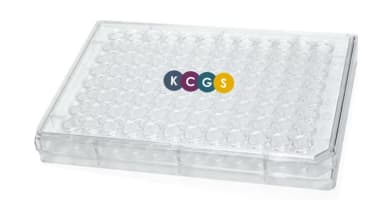The Kinase Chemogenomic Set (KCGS)
Invented by The SGC-UNC laboratories
Invented at The University of North Carolina at Chapel Hill , Structural Genomics Consortium (SGC)
- Datasheet
- References (5)
- Inventor Info
Info
| Catalogue Number | 157681 |
| Antigen/Gene or Protein Targets | The list of kinases covered by the inhibitors in KCGS v1.0 and their distribution across the human kinome: AAK1 ABL1 ACVR1 ACVR1B ACVRL1 AKT1 AKT2 ALK ATM ATR AURKA AURKB AURKC BLK BMP2K BMPR1A BMPR1B BMPR2 BMX BRAF BRSK1 BRSK2 BTK BUB1 CAMKK1 CAMKK2 CASK CDK1 CDK2 CDK3 CDK4 CDK7 CDK8 CDK9 CDK12 CDK13 CDK19 CDKL2 CDKL5 CHEK1 CHEK2 CIT CLK1 CLK2 CLK3 CLK4 CSF1R CSNK1A1 CSNK1D CSNK1E DAPK3 DCLK3 DDR1 DYRK1A DYRK1B DYRK2 EGFR EIF2AK3 EPHA2 EPHA6 EPHB4 EPHB6 ERBB2 ERBB3 ERBB4 ERN1 FER FES FGFR1 FLT1 FLT3 FLT4 FRK GAK GSG2 GSK3A GSK3B HCK HIPK1 HIPK2 HIPK3 HIPK4 ICK IGF1R IKBKB IKBKE INSR INSRR IRAK1 JAK1 JAK2 JAK3 KDR KIT LATS1 LCK LIMK2 LRRK2 LTK LYN MAP2K1 MAP2K3 MAP2K4 MAP2K5 MAP3K2 MAP3K5 MAP3K7 MAP3K11 MAP3K19 MAP3K20 MAP4K2 MAP4K4 MAPK1 MAPK3 MAPK6 MAPK7 MAPK8 MAPK9 MAPK10 MAPK11 MAPK14 MAPK15 MAPKAPK2 MAPKAPK5 MARK3 MELK MET MINK1 MKNK1 MKNK2 MTOR MUSK MYLK MYLK2 NEK2 NEK3 NEK5 NEK6 NEK9 NLK NTRK1 NTRK2 NTRK3 NUAK1 NUAK2 PAK1 PDGFRA PDGFRB PDPK1 PHKG1 PI4KB PIK3C2B PIK3C2G PIK3C3 PIK3CA PIK3CB PIK3CD PIK3CG PIM1 PIM2 PIM3 PIP4K2C PIP5K1C PKN2 PLK1 PLK2 PLK3 PRKAA2 PRKCD PRKCE PRKCH PRKCQ PRKD1 PRKD2 PRKD3 PRKX PTK2 PTK2B PTK6 RAF1 RET RIOK1 RIOK2 RIPK1 RIPK2 RIPK3 ROCK1 ROCK2 RPS6KA1 RPS6KA2 RPS6KA3 RPS6KA4 RPS6KA5 RPS6KA6 RPS6KB1 SIK1 SRC SRMS STK10 STK16 STK17A STK17B STK36 SYK TAOK3 TBK1 TEK TGFBR1 TNK1 TNK2 TNNI3K TTK TYK2 YES1 ZAP70 |
| Relevance |
Designed to study the biology of dark kinases from the human genome. Background and Research Application The Kinase Chemogenomic Set (KCGS) is the most diverse and highly annotated, publicly-available collection of kinase inhibitors. Version 1.0 of the set contains 187 kinase inhibitors sourced from eight pharma companies and academic laboratories with potent activity on 215 human kinases. A version 2.0 has now become available with 113 additional kinase inhibitors, for a total of 300 inhibitors. Sets like KCGS can help identify medically important kinases and allow the synthesis of high-quality chemical probes for high priority dark kinases of therapeutic interest. Dark kinases are those which are difficult to characterise, have little biological information gathered and their medical potential is unreached/untested. The goal of the KCGS is to generate, systematize and disseminate knowledge about dark kinases, biological networks in which they function and connections to cellular phenotypes and human disease. There is a vast array of small molecule drugs, including at least 38 cancer therapies, which function by inhibiting the action of protein kinases, or similar lipid kinases. An enhanced understanding of signalling networks, particularly those which control the immune system, should eventually lead to drug discoveries. The KCGS aims to: (i) establish a knowledgebase covering the approximately 160 poorly understood “dark kinases”, (ii) distil primary data into functional biochemical and biological information and promote further research using genetic and chemical tools, which they are also developing and making available, (iii) place dark kinases within a new and emerging network-level understanding of cell signalling and physiology and (iv) identify those dark kinases whose mutation or mis-regulation is associated with human disease, making them possible therapeutic targets. The KCGS, is a collection of narrow spectrum, small molecule kinase inhibitors that has been assembled by the SGC-UNC to study the biology of dark kinases. |
| Research Area | Drug Discovery & Development |
| Notes |
Points of Interest Each inhibitor has been screened across hundreds of kinases and only those meeting strict selective criteria are included in the set. The Kinase Chemogenomic Set (KCGS) has been designed to study the biology of dark kinases from the human genome and uncover new molecular targets for drug discovery. Visit https://www.thekcgs.com/ to see current projects using KCGS. For more information on KCGS or for commonly asked questions, please visit https://www.sgc-unc.org/faq. |
References: 5 entries
KCGS FAQs
The Kinase Chemogenomic Set (KCGS): An open science resource for kinase vulnerability identification
Burdova et al. 2019. EMBO J. 38(20):e101443. PMID: 31424118.
Wells et al. 2018. Medchemcomm. 9(1):44-66. PMID: 30108900.
Drewry et al. 2017. PLoS One. 12(8):e0181585. PMID: 28767711.
Add a reference
References: 5 entries
KCGS FAQs
The Kinase Chemogenomic Set (KCGS): An open science resource for kinase vulnerability identification
Burdova et al. 2019. EMBO J. 38(20):e101443. PMID: 31424118.
Wells et al. 2018. Medchemcomm. 9(1):44-66. PMID: 30108900.
Drewry et al. 2017. PLoS One. 12(8):e0181585. PMID: 28767711.
Add a reference
Inventor Information
Inventors

|
The SGC-UNC laboratories |









